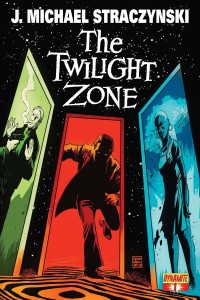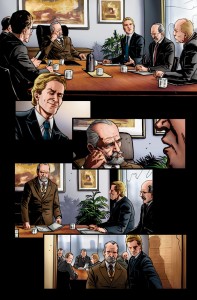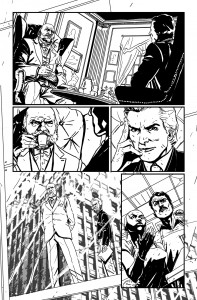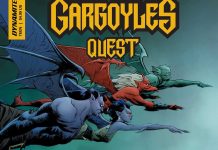By Jeffrey O. Gustafson

Straczynski is a natural choice for the series. After meeting Serling as a youth, Straczynski would go on to Hollywood, with his well-regarded work on 1980s The Twilight Zone revival being his big break into live-action television. For Straczynski, working on The Twilight Zone is a kind of homecoming.
As the first issue becomes available for order, I interviewed Straczynski about his plans for the series, and how Rod Serling and The Twilight Zone changed his life. I also ask Vilanova and Dynamite publisher Nick Barrucci about the genesis of the project and their personal favorite Twilight Zone stories.
First, how did the project develop and how did each of you get involved?
NB: I’ve always been a fan of the Twilight Zone TV show and it’s a license we’ve wanted to tackle for years. We had talked to CBS about it off and on. What we wanted to do was ensure when we got the license we could to it justice. So we kept in touch, followed up diligently, ensuring that we didn’t miss out on the opportunity to throw our hat in the ring, but we were quite clear that we only wanted to do it if we could do it right.
GV: I worked with my friends of Dynamite on the Dark Shadows series and Dark Shadows: Year One miniseries, and I really wanted to do something big. When Joe and Nick offered me this amazing project, I couldn’t refuse.
JMS: Nick and I had been talking about other projects, and he mentioned that he might go for the Twilight Zone title if I had an interest in writing it. Leaving aside that this is an extraordinary compliment, I’ve always had a strong tie to the Twilight Zone, having worked on the ’88 version and growing up a tremendous fan of Rod Serling’s work. I even co-wrote a guide to his Night Gallery series for Twilight Zone Magazine.
And in addition to all the Twilight Zone television work, one of the first few comics you ever wrote was a Twilight Zone comic for defunct Now Comics way back in 1991…
JMS: The book was actually an adaptation of the spec script I wrote for the New Twilight Zone that got me in the door to write the script for “What Are Friends For?”
Nick, you approached Joe about working on the book from the very beginning – what made him the ideal candidate?
NB: I’ve known Joe for years, and I’ve always wanted to work with him on this level, but there didn’t seem to be the right property for us to work together on. Over the years, we’ve kept in touch, and I’ve always hoped to work with him. One day I was in the office looking over ideas from one of our editorial meetings for potential licenses, and I was looking at Twilight Zone, and thought, why not ask Joe. He’d worked on it. I knew he was a huge fan of Rod Serling, but wasn’t sure if he’d feel like he’d said all that he had to say or if he would like to jump in. Worst case he would say no, right? … I asked him if he was interested and he enthusiastically said “yes.” What made him the ideal candidate? He brings so much passion and reverence to the property yet at the same time comes in with a distinct voice and I can’t over emphasize how much his knowledge of the property, yet his ability to come up with a crisp story is important. I can honestly say that Joe is the only person we approached, and he is the right person.

JMS: I kind of blended them all together into this one story. It’s actually three separate stories told from three points of view that slowly begin to merge together into one larger, meta-story. One is a very grounded thriller, the other is a much bigger, apocalyptic story, and the other deals with time travel. Some folks online have said that the issues should be stand-alone stories, but that misses a very key point: if you extract the amount of script from the average comic book, it’s equal to maybe ten or twelve TV script pages. So if you put 3-4 issues together, you have the equivalent of one half-hour TV episode. You can’t do a Twilight Zone story in ten pages, or one twenty-two page comic book; you need to be able to establish and develop the character, and that takes time. You could never do a single comic book with the depth of storytelling you’d get in, say, “The Monsters Are Due on Maple Street,” or “The Obsolete Man.” So by doing our stories in 4 issue arcs we’re doing just what would’ve been done in one episode.
The other thing about the Zone that sometimes folks tend to forget in the cloud of nostalgia that surrounds the title was that it was a proving ground for all kinds of storytelling, from the prosaic (“Mr. Denton on Doomsday”) to the more experimental (“Five Characters In Search of an Exit”). The structure wasn’t there in network television to do three seemingly independent episodes that suddenly turn out to have connections to one another, and sew together into a larger narrative. The syndication market at that time aired episodes in any order they liked; it wouldn’t have worked. Had this sort of technique been available at the time, who knows whether or not it would’ve been used, but knowing Serling’s tendency toward experimentation, I’d bet good money he’d give it a shot. The Twilight Zone was about looking forward, to the future, to trying new storytelling approaches, not about nostalgia for a long-ago form (except as a subject of stories, natch).
Obviously Twilight Zone is known for its twist endings–
JMS: That’s kind of the perception, but if you look at the show as a whole, twist endings (“To Serve Man,” “Time Enough at Last”) were generally about a third of what was actually produced. They have a lot of impact in retrospect, but there were far more non-twists than twist endings. If anything, Serling seemed to lean away from those later on in the Zone‘s run, because in time the twist can become predictable. Some of the non-twist episodes include “Night Calls,” “Nightmare at 20,000 Feet” and “Steel,” among many others. So we’re not specifically going for a twist ending to the stories, though there are a number of twists and turns that should surprise readers.
What will be the structure of the series and how long is your initial run?
JMS: I’m doing twelve issues in three four-issue arcs, as noted above. Each is built around a protagonist in one specific area, who know or are associated with each other. The stories are told in sequence, each starting from a common point, around that character. In the background of each story, however, we get glimpses of what’s happening in the other two stories. (Meaning: in the background of a scene with a Wall Street banker in arc one, we see an investigator from the second arc following a lead.) So in essence, all three stories are happening simultaneously. (It’s like telling a story about character A from Monday-Saturday; you finish that story, then rewind the clock to Monday and show what happened to character B during that same period.)
You can print the stories as three individual arcs or, and here’s the fun of it, you could conceivably interleave the three stories like shuffling a deck of cards and turn the whole thing into one larger narrative that turns the whole thing around in the end. It’s not a structure we’ve seen a lot before, so it’s fun to do, though keeping track of all three stories so that the time-frame is consistent throughout is a bit of a headache.
Nick, are there plans to continue the series after Joe and Guiu’s run?
NB: I’m pretty sure we will, especially since Joe will create so much awareness for the series. But time will tell. Right now the focus is on putting out a great series. Let’s me put it this way. When Joe and I first started talking about this he was thinking this would be a four issue story arc, and we were elated. Joe writing four issues, that’s great, it helps rebrand the property for the comic and the market, creates great awareness, then the hard part is finding someone to fill Joe’s shoes. Not the worst problem to have, but it’s still a challenge to work with someone who wants to follow Joe up and do as good of a job. It would be tough, but again, not a bad problem to have. Then Joe was so excited he suggested writing the first four issues, we bring another writer on board to script the next four, then he would write 4 more as he had another story. Of course I said yes, there’s no doubt about that. Then he came back and said that he has a story for all twelve issues, “how about I write the first 12 issues.” That says it all. That’s what made him the ideal candidate. He kept coming up with more and more ideas that kept growing, adding to the story and he just knocks it out of the park. What can I say?

JMS: As we discovered when I worked on the Zone in ’88, people have certain fixed notions about what constitutes a Twilight Zone story, because we’ve had it in our lexicon for decades… a perception that actually didn’t exist at the time because the fun of watching the Zone in its original broadcast was that viewers never knew what to expect next. So we have to address that here as well.
The other challenge is that at its heart, the Twilight Zone was about – as Faulkner said – the human heart in conflict with itself. It wasn’t generally about big explosions or action set-pieces. A lot of it was two people in a room talking about really important stuff. So the challenge becomes keeping that dialogue-rich narrative without it becoming dull in comic form.
How has Rod Serling’s work and The Twilight Zone specifically impacted your life and career?
JMS: Jesus, how hasn’t it? Growing up I watched every episode of the original Zone scores of times; there are some episodes, like “Little Girl Lost,” or “The Monsters Are Due on Maple Street” that I’ve probably seen close to a hundred times. I studied them as a kid, and when I was in high school at a career day held at a local college, the same day that Rod was scheduled to talk, he wandered in and read a couple of my stories, giving me my first validation as a writer. Later, selling a Twilight Zone script became my first live-action sale, and paved the way for me to get the job on Captain Power (which required a minimum of one live-action produced script, which is what that gave me), and positioned me to come on as story editor a year later, where I wrote a new Zone episode based on an unproduced Serling outline. It was the Zone gig that opened up other doors for me in my career. There are more ways even beyond all that in which the Zone has played an important part in my life and my career, but it would take several more screens to tell it all.
So this is far from your first foray into The Twilight Zone. How is your previous work with the franchise coloring your work on the project today?
JMS: I’m trying to let it do so, because I’m not the same writer today that I was in ’88. I learned a lot from that experience about what the Zone was and wasn’t, and those lessons have had a chance to take root and mature, so my understanding of that now is quite a bit different from what it was then. Also, having run shows gives me a better understanding of what kinds of stories you can do in television, and the constraints under which Rod had to work, so that also informs the storytelling.
I know it’s difficult to appraise one’s early work, but what are some of your favorite Twilight Zone stories that you have worked on?
JMS: My favorite three would be: “Dream Me a Life” with Eddie Albert playing a man in a retirement home who begins to share dreams with the comatose woman next door, because of how the writing worked out but also because of what Eddie brought to that role… “The Mind of Simon Foster,” about a desperate man who begins selling his memories at a special kind of pawn shop and begins to realize the cost of what he’s doing… and “Our Selena is Dying,” about an elderly woman who begins to draw the life and vitality out of a younger woman, which I wrote based on an outline by Rod Serling. Seeing my name on the same screen as Rod’s was a once-in-a-lifetime thrill.
Guiu and Nick, what does The Twilight Zone mean for you? What are some of your favorite episodes?
GV: Twilight Zone was one of the series that marked my childhood. I saw the first five seasons, long time after the airing of the last episode in the USA. I think in 90’s. The first episode I saw was “Time Enough at Last” from the first season, and I really liked the episode “A Hundred Yards over the Rim.”
NB: Twilight Zone means endless imagination for creating new stories, having the right twist from start to finish, being smart with the stories you tell. That’s really what it means to me. “Where is Everybody” is a great one for me, I would say “Time Enough at Last,” “Walking Distance,” “The Afterhours,” “The Eye of the Beholder” and “The Invaders.”
The incomparable Francesco Francavilla is doing a cover–
NB: Francesco is doing all the covers and you’re right, he is incomparable. He’s a genius and draws some of the best covers on the market today and we are very luck to have him.
Joe, what does Guiu bring to the table as an artist?
JMS: He brings a very grounded art style that works well with the stories we’re doing, especially the first one, as that’s the most character-oriented. You can feel the weight of the characters in his art and that’s very important for the stories to work.
Bottom line: for me as a writer, but also as a fan of Serling’s work, and the Zone, there are few things more exciting than to be able to return to that universe, to that title, and tell another story that pushes the boundaries and delves deep into the important questions that we all have to deal with every day. In a very weird way, writing The Twilight Zone is a lot like coming home….
—
Twilight Zone #1 (NOV130938) is written by J. Michael Straczynski, illustrated by Guiu Vilanova, and published by Dynamite Comics. It is currently available for order from Diamond Comics and your local comic shop, for a January scheduled release.








Looking forward to this, glad they are going with color too.
No better person than JMS to write this, considering his history. I’m glad he “gets” what Twilight Zone is all about, as opposed to those that think it has to be a story with a twist ending. Looking forward to this and I hope if JMS leaves that they get some other talented writers like Mark Waid involved with writing a story.
Comments are closed.